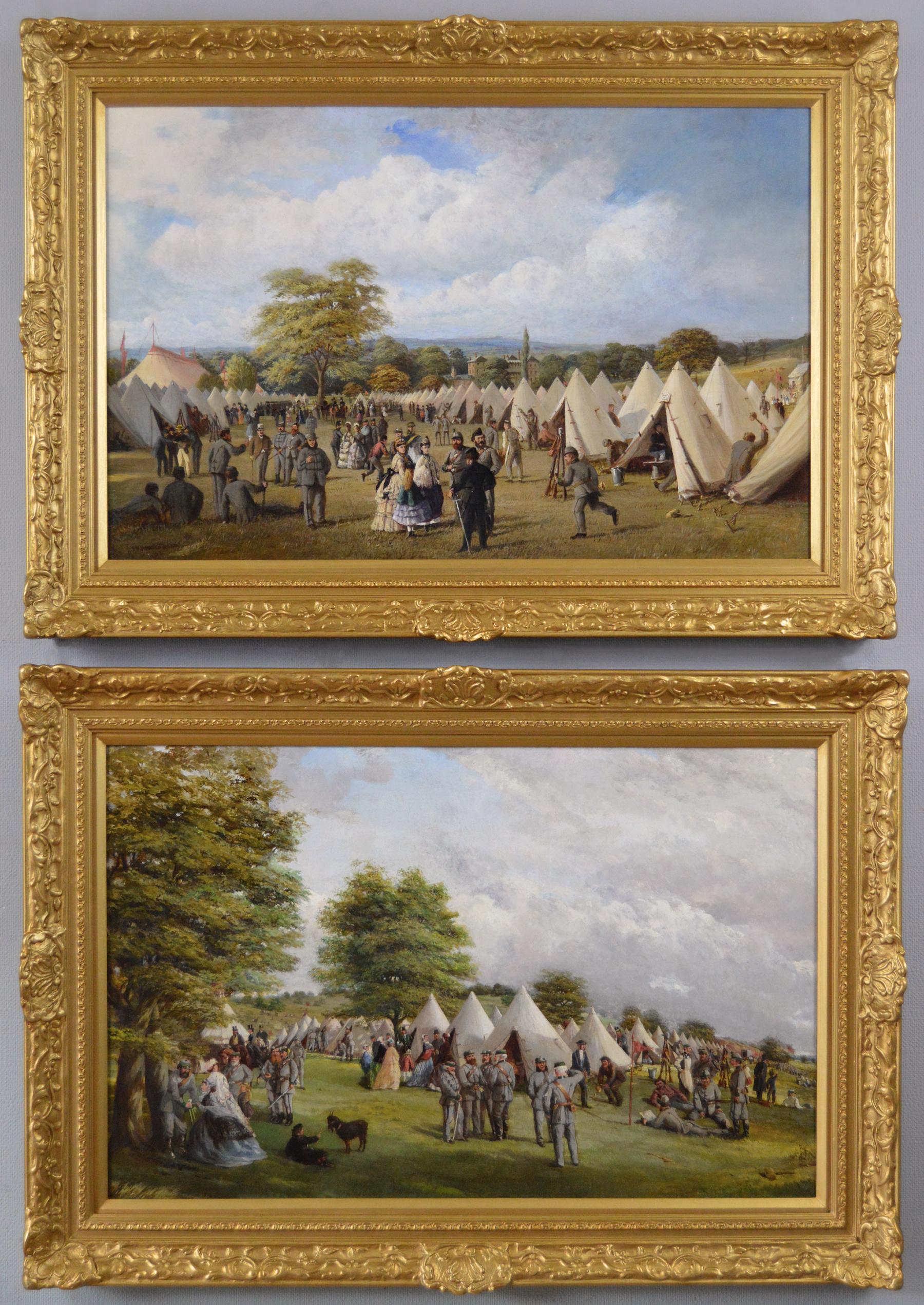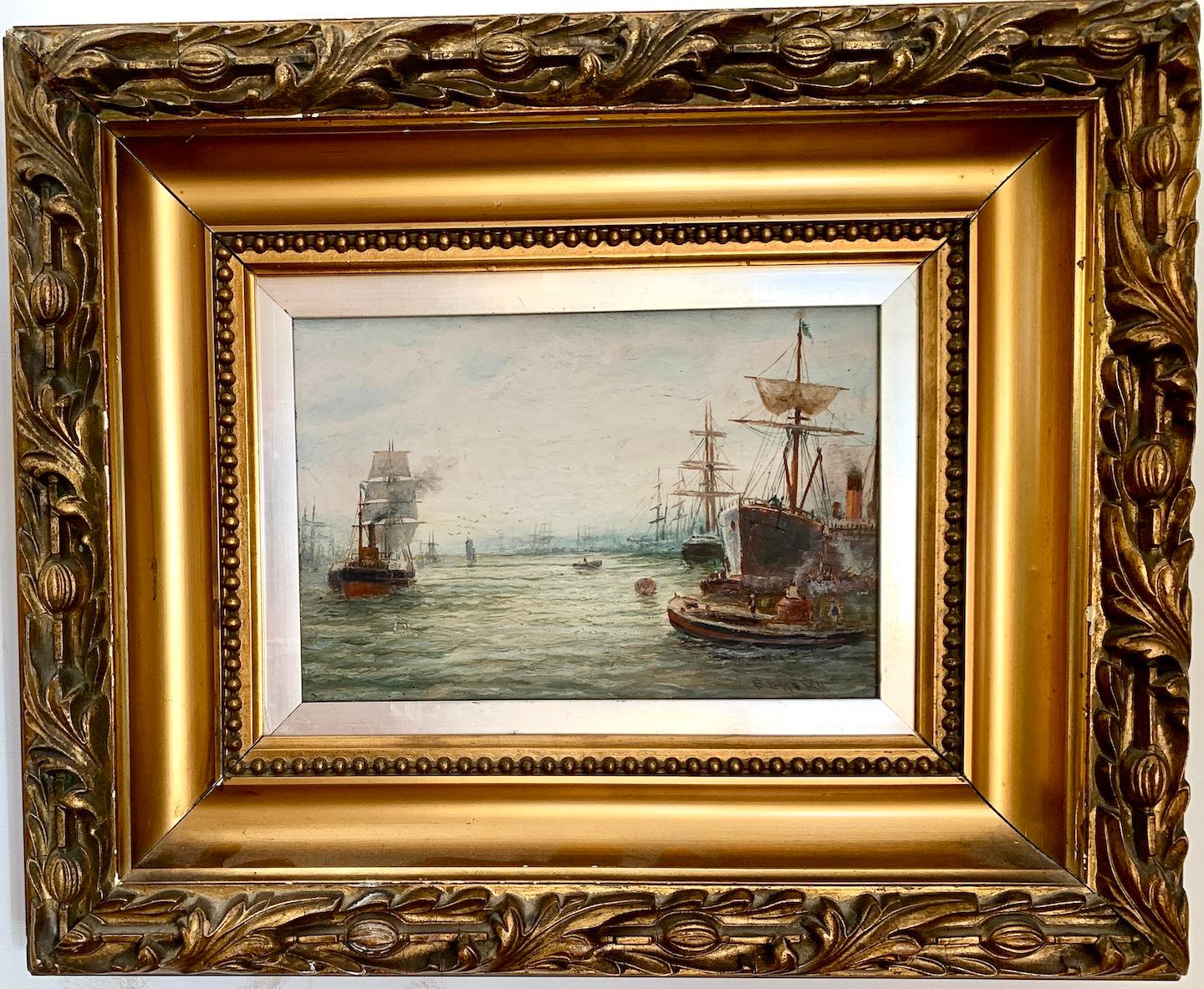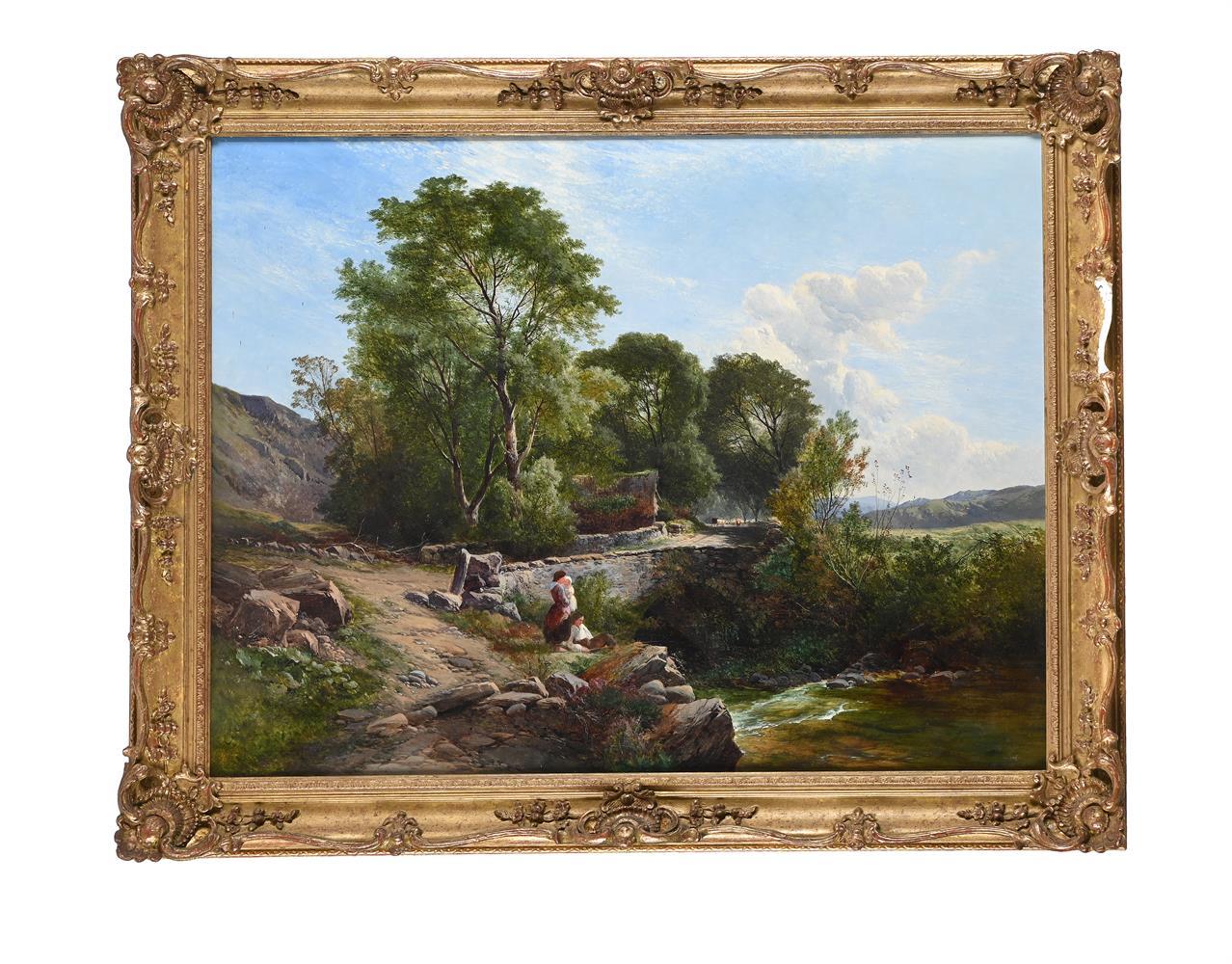Items Similar to 19th Century North African river landscape oil painting of a man using a Shadoof
Want more images or videos?
Request additional images or videos from the seller
1 of 15
David Bates b.184019th Century North African river landscape oil painting of a man using a ShadoofC1900
C1900
About the Item
David Bates
British, (1840-1921)
The Shadoof
Oil on canvas, signed, further inscribed verso
Image size: 19.75 inches x 29.75 inches
Size including frame: 26.25 inches x 36.25 inches
A North African river landscape painting of a man using a Shadoof by David Bates. As the man fills the bucket, another waits with camels whilst two figures tend to a flock of sheep. In the distance, other figures and animals can be seen near a village. A Shadoof or Shaduf is a hand operated system for lifting water that was invented in Ancient Egypt and used mainly for irrigation. It consists of a pivoted pole with a bucket at one end and a counterweight at the other. They are still used in parts of Egypt, Africa and India today.
David Bates was born in March, Cambridge in 1840 to Benjamin Bates a shoe maker and Sarah Bates. By 1851, the family had moved to Upton upon Severn in Worcestershire and from 1855 Bates became an apprentice at the Royal Worcester Porcelain Works in Worcester. There he developed his artistic talent, painting flower decorations onto vases and plates. At some point after 1861, he became a full time artist and made his debut at the Royal Academy in 1863, continuing to exhibit there until 1893. He also exhibited at the Royal Birmingham Society of Artists, Suffolk Street and the Grosvenor Gallery.
He married Elizabeth Higgs from Worcester in 1867 and they lived at Cherry Orchard, Bath Road in Worcester where their children were later born. Their second child John Bates Noel (1870-1927) became a landscape artist and their younger son David Samuel became an art agent. Around 1879 he moved to nearby Great Malvern living at Hollymount Cottage in St Ann’s Road and then at Sydenham Villa, Newtown Road. By 1891, the family had moved to Birmingham where they lived at 158 Pershore Road in Edgbaston and later Chantry Road, in Kings Norton. Sometime after 1901, he relocated to Surrey where he lived at Blandford House, Teddington. He died on 21 February 1921 at Teddington and was buried in Kingston-upon-Thames Cemetery.
Bates often travelled around Wales and the Midlands and became known for his open air painting of the area, however, he also visited other beauty spots such as the Lake District. He also spent time in North Africa painting, producing a number of works from his travels. His style and subjects were influenced by Benjamin Williams Leader and were similar to that of other members of the Birmingham School such as Joseph Thors and S.H. Baker.
Examples of his work are held in many public collections including the Canterbury Museum, Derby Museum, Dudley Museum, Hartlepool Museum, Malvern Museum, Nottingham Castle Museum, Walker Art Gallery, Wednesbury Museum, The Wilson, Wolverhampton Art Gallery and the Worcester City Museum.
Presentation: The painting is housed in a new, English made gilt frame which is in excellent condition.
Condition: As with all of our original antique oil paintings, this work is offered in ready to hang gallery condition, having just been professionally cleaned, restored and revarnished.
© Benton Fine Art
- Creator:David Bates b.1840 (1840 - 1921, British)
- Creation Year:C1900
- Dimensions:Height: 26.25 in (66.68 cm)Width: 36.25 in (92.08 cm)Depth: 2.5 in (6.35 cm)
- Medium:
- Movement & Style:
- Period:
- Condition:
- Gallery Location:Nr Broadway, GB
- Reference Number:1stDibs: LU15627261062
David Bates b.1840
David Bates was an English landscape artist who painted in oils and watercolour. He was born in Cambridge, and from 1855 worked as a porcelain painter at the Royal Worcester porcelain works in Worcester - where he came to specialise in painting flowers. He left his employment there in 1880 to become a full-time professional painter. Bates was an "open-air" rural landscape artist, painting in the Midlands, Scotland and Wales, and abroad in Switzerland and Egypt. His work shows the influence of Benjamin Williams Leader, Joseph Thors and Samuel Henry Baker, and Bates is associated in style with the Birmingham School of artists. Bates exhibited many works at the Royal Academy, Grosvenor Gallery, Royal Society of British Artists and the New Watercolour Society in London, and at the Royal Birmingham Society of Artists. His works are currently on display in Liverpool museum, Worcester City Museum, and several other art galleries.
About the Seller
4.9
Platinum Seller
These expertly vetted sellers are 1stDibs' most experienced sellers and are rated highest by our customers.
Established in 1972
1stDibs seller since 2015
273 sales on 1stDibs
Typical response time: <1 hour
Associations
The British Antique Dealers' AssociationLAPADA - The Association of Arts & Antiques DealersInternational Confederation of Art and Antique Dealers' Associations
- ShippingRetrieving quote...Ships From: Nr Broadway, United Kingdom
- Return PolicyA return for this item may be initiated within 3 days of delivery.
More From This SellerView All
- 19th Century genre oil painting of two boys fishingBy Herbert William WeekesLocated in Nr Broadway, WorcestershireHerbert ‘William’ Weekes British, (1841-1914) Admiring the Catch Oil on canvas, signed Image size: 30 inches x 21.5 inches Size including frame: 36.5 inches x 28 inches A wonderful...Category
19th Century Victorian Figurative Paintings
MaterialsOil, Canvas
- Pair of 19th Century military oil paintings of volunteer rifle soldiersLocated in Nr Broadway, Worcestershire**PLEASE NOTE: EACH PAINTING INCLUDING THE FRAME MEASURES 26.25 INCHES X 37.25 INCHES** Frederick Henry Howard Harris British, (1829-1901) Volunteer Rifl...Category
19th Century Victorian Figurative Paintings
MaterialsOil, Canvas
- Early 20th Century Worcestershire landscape oil painting of a plough teamBy David Bates b.1840Located in Nr Broadway, WorcestershireDavid Bates British, (1840-1921) The Plough Team, Bredon’s Norton Oil on canvas, signed & dated 1908, further inscribed verso Image size: 15.5 inches x 23.5 inches Size including frame: 21.5 inches x 29.5 inches A lovely landscape painting of a plough team on a country track near Bredon’s Norton by David Bates. Bredon’s Norton is a village located in the Cotswolds, on the slopes of Bredon Hill in South Worcestershire. The America women’s rights activist Victoria Woodhull Martin moved to the village in 1901 and by 1908 had set up an agricultural school for women at her Norton’s Park estate. The Antarctic explore Raymond Priestley also lived there. Although Bates was living in Surrey at the time of this painting, he would have been familiar with the area after having lived and worked in Worcestershire for some considerable time. He would have also most likely been aware of Victoria Woodhull Martin and the school. David Bates was born in March, Cambridge in 1840 to Benjamin Bates a shoe maker and Sarah Bates. By 1851, the family had moved to Upton upon Severn in Worcestershire and from 1855 Bates became an apprentice at the Royal Worcester Porcelain Works in Worcester. There he developed his artistic talent, painting flower decorations onto vases and plates. At some point after 1861, he became a full time artist and made his debut at the Royal Academy in 1863, continuing to exhibit there until 1893. He also exhibited at the Royal Birmingham Society of Artists, Suffolk Street and the Grosvenor Gallery. He married Elizabeth Higgs from Worcester in 1867 and they lived at Cherry Orchard, Bath Road in Worcester where their children were later born. Their second child John Bates Noel (1870-1927) became a landscape artist and their younger son David Samuel...Category
19th Century Victorian Landscape Paintings
MaterialsOil, Canvas
- 19th Century genre landscape oil painting of three boys fishing on a riverBy William BromleyLocated in Nr Broadway, WorcestershireWilliam Bromley British, (1816-1890) Gone Fishing Oil on canvas, signed Image size: 13.5 inches x 17.5 inches Size including frame: 18.75 inches x 22.75 inches A picturesque genr...Category
19th Century Victorian Figurative Paintings
MaterialsOil, Canvas
- Historical oil painting of the surrender of Don Pedro De Valdez to Francis DrakeBy John Seymour LucasLocated in Nr Broadway, WorcestershireJohn Seymour Lucas RA British, (1849-1923) The Surrender of Don Pedro De Valdez to Sir Francis Drake Oil on canvas, signed & dated 1889 Image size: 19.5 inches x 30.5 inches Size including frame: 27 inches x 38 inches This fantastic historical scene by John Seymour Lucas depicts the surrender of Don Pedro De Valdez to Sir Francis Drake, aboard the Revenge during the Spanish Armada off Portland on 1 August, 1588. Don Pedro de Valdez was the commander of the Squadron of Andalusia and was on board the Nuestra Señora del Rosario when it was taken in action by Drake in the Revenge. A full sized version of this painting is held by the National Trust and can be found at Buckland Abbey, Devon. John Seymour Lucas was born in London on 21 December, 1849 to Henry and Elizabeth Lucas (née Seymour). He was the nephew of the portrait painter John Lucas and two of his children, Sydney Seymour...Category
19th Century Victorian Figurative Paintings
MaterialsOil, Canvas
- 19th Century genre oil painting of a woman in a garden with two girlsBy William Stephen ColemanLocated in Nr Broadway, WorcestershireWilliam Stephen Coleman British, (1829-1904) By the Fish Pond Oil on canvas, signed & dated 1898 Image size: 23 inches x 35 inches Size including frame: 30.25 inches x 42.25 inches A beautiful painting by William Stephen Coleman of a woman with two girls in a semi classical style by a Mediterranean pond. The woman is depicted resting on a terrace with her young daughter asleep on her lap, whilst another child catches goldfish in a bowl. This tour de force would have most likely been painted by Coleman as an exhibition piece. William Stephen Coleman was a figurative painter who was born in Horsham in 1829. He was one of 12 children born to a physician named William Thomas Coleman and his wife Henrietta (née Dendy). Three of his siblings Rebecca Coleman (b1837), Helen Cordelia Angell (1847–1884) and George Coleman also became artists, inheriting their artistic talent from their mother’s side of the family. Coleman developed an interest in nature from an early age, producing drawings as a hobby. Despite his ability, he initially followed in his father’s footsteps and trained as a surgeon. However, this proved unsuccessful and by the age of 21 he had turned back to art, later gaining employment with the Dalziel Brothers, a firm of wood engravers who specialised in natural history illustrations. Sometime during the late 1850’s he moved to London where he married his first wife Henrietta Augusta Boultbee in 1858. Around the same time, he began producing illustrations for books; the first of which was entitled ‘Common Objects of the Country’ and published in 1858. He subsequently published two of his own books ‘Our Woodlands. Heaths, and Hedges’ in 1859 and ‘British Butterflies’ in 1860. After the death of his wife in 1860, his sister Rebecca and brother George went to live with him in Garway Road, Paddington. Rebecca would often assist him with the wood blocks for his illustrations. As well as working as an engraver, he also began producing classically influenced paintings featuring figures in landscapes. Initially these were executed in watercolours but later extended to oil paintings. He began exhibiting at the Dudley Gallery in 1865 and was one of the original committee members. He continued to exhibit there until 1879 and was a committee member up until 1881. By 1869, he had also begun to work on pottery decoration and in 1871 was asked by Minton’s to establish an Art Pottery Studio at Kensington Gore. Whilst at Minton’s, he produced figure designs for their ceramic ware. His sister Rebecca also worked at Minton’s and they moved to Belle Vue in Chelsea to be closer to the studio. From 1881, he lived at 3 St John’s Wood Studios, Queens Terrace in Paddington and in 1888 moved to 43 Broadhurst Gardens in Hampstead. In 1893 one of his classically inspired works ‘The Gold Fish Bowl...Category
19th Century Victorian Figurative Paintings
MaterialsOil, Canvas
You May Also Like
- 19th century English marine, The Thames at the Pool of London, original frameBy Bernard Benedict HemyLocated in Woodbury, CTBernard Hemy - Bernard Benedict Hemy (1844 - 1910). Marine and Coastal painter in oil and watercolor. Born in Newcastle to Henry F. Hemy, brother...Category
1890s Victorian Landscape Paintings
MaterialsCanvas, Oil
- 19th century English Victorian oil landscape with figures, a stream and treesBy Henry John BoddingtonLocated in Woodbury, CTHenry John Boddington. 19th century English landscape with figures by a riverside. Simply one of the finest quality English landscape Ive ever had the pleasure of owning . This i...Category
1850s Victorian Landscape Paintings
MaterialsCanvas, Oil
- Antique 19th century English fishing vessels In the English ChannelBy William Henry WilliamsonLocated in Woodbury, CTAntique 19th century English fishing vessels In the English Channel William Henry Williamson was a gifted, London painter of coastal scenes, ...Category
1880s Victorian Figurative Paintings
MaterialsOil, Canvas
- 19th century French scene of Lovers walking in a Garden, in 17th century costumeLocated in Woodbury, CT19th century French scene of Lovers walking in a Garden, in 17th century costume original frame Wonderful 19th century classical Genre scene, painted with great skill and delicasicy . The artist has captured the meetiung of the two lovers...Category
1870s Victorian Figurative Paintings
MaterialsOil, Canvas
- 19th century English village scene with cottages, horses landscape and peopleBy Georgina LaraLocated in Woodbury, CTGeorgine Lara English Village landscape A painting by Georgina Lara depicting a 19th-century English village scene offers a charming and evocative portrayal of a bygone era, captur...Category
1890s Victorian Landscape Paintings
MaterialsOil, Canvas
- 19th century English village scene with cottages, horses landscape and peopleBy Georgina LaraLocated in Woodbury, CTGeorgine Lara English Village landscape A painting by Georgina Lara depicting a 19th-century English village scene offers a charming and evocative portrayal of a bygone era, captur...Category
1890s Victorian Landscape Paintings
MaterialsOil, Canvas
Recently Viewed
View AllMore Ways To Browse
Man Painting Antique
Son Of Man
Son Of A Man
Victorian Man
African Child
Oil Painting Man 19th
19th Century African Art
Oil Painting 19th Century Man
Oil Painting Man 19th Century
Oil Painting 1840
1840 Flowers
India Antique Painting
David Samuels
Antique Paintings Of India
Signed Bat
Man Shoes
19th Century Painting India
Antiques Of India






